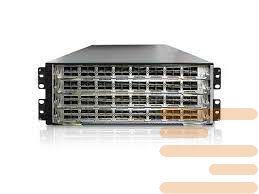Switch Huawei CloudEngine 9860-4C-EI-A
65 MB Huawei Ethernet Switch 4 Slots Gigabit Network Switch Huawei PoE Ethernet Switch
Switches CloudEngine 9800 series from Huawei — these are high-performance, high-quality, reliable, and stable Ethernet units 100G. They are used for data center networks, with high-density 100GE ports and low latency.
Switches are compatible with a number of other line models CloudEngine (CE 16800, 12800, 8800, 6800 and 5800). Hardware devices of the series CloudEngine 9800 can be used to build an elastic, virtualized, high-quality structure that will strictly meet the strict requirements of cloud computing and data centers.
Switches operate on a hardware structure that provides high-density ports 100 GE/40 GE to support diverse functions of the data center and can function as core or aggregation switches in data center networks.
Technical specifications switch Huawei CloudEngine CE8860-4C-EI:
|
Item |
CE8860-4C-EI |
|
Ports |
4 slots, different cards can be flexibly used in combinations to achieve a maximum of: 32 x 100 GE QSFP28 or 64 x 40 GE QSFP+ or 128 x 25 GE SFP28 or 128 x 10 GE SFP+ ports |
|
Dimensions (W x D x H) |
442 mm x 600 mm x 88.1 mm |
|
Weight (fully loaded) |
21.2 kg (46.7 lb) |
|
Operating Voltage |
Rated voltage: 100V AC to 240V AC, 50 Hz to 60 Hz Maximum voltage: 90V DC to 290V AC, 47 Hz to 63 Hz 240V high-voltage DC power voltage: 188V to 290V DC 380V high-voltage DC rated voltage: 240V to 380V DC 380V high-voltage DC maximum voltage: 188V to 400V DC |
|
Maximum Power Consumption |
750W |
|
Switching Capacity |
6.4 Tbit/s |
|
Forwarding Performance |
3,200 Mpps |
|
Airflow Design |
Front-to-back or back-to-front |
|
Network Virtualization |
VXLAN routing and bridging |
|
BGP-EVPN |
|
|
TRILL |
|
|
QinQ access VXLAN |
|
|
IPv6 over VXLAN |
|
|
SDN |
Agile Controller |
|
VMware NSX |
|
|
Network Convergence |
FCoE |
|
DCBX, PFC, ETS |
|
|
Programmability |
OPS |
|
CE modules for Ansible released on open source websites |
|
|
Traffic Analysis |
NetStream |
|
sFlow |
|
|
VLAN |
Adding access, trunk, and hybrid interfaces to VLANs |
|
Default VLAN |
|
|
QinQ |
|
|
MUX VLAN |
|
|
GVRP |
|
|
ACL |
Ingress: 2,000; Egress: 1,000 |
|
MAC Address Table |
Maximum: 136k |
|
Dynamic learning and aging of MAC addresses |
|
|
Static, dynamic, and black hole MAC address entries |
|
|
Packet filtering based on source MAC addresses |
|
|
MAC address limiting based on ports and VLANs |
|
|
ARP |
Maximum: 84k |
|
IPv4 FIB |
Maximum: 128k |
|
IP Routing |
IPv4 routing protocols, such as RIP, OSPF, BGP, and IS-IS |
|
IPv6 routing protocols, such as RIPng, OSPFv3, IS-ISv6, and BGP4+ |
|
|
IPv6 FIB |
Maximum: 64k |
|
ND |
Maximum: 32k |
|
IPv6 |
IPv6 Neighbor Discovery (ND) |
|
Path MTU Discovery (PMTU) |
|
|
TCP6, ping IPv6, tracert IPv6, socket IPv6, UDP6, and Raw IP6 |
|
|
Multicast FIB |
Maximum: 8k |
|
Multicast |
IGMP, PIM-SM, PIM-DM, MSDP, and MBGP |
|
IGMP snooping |
|
|
IGMP proxy |
|
|
Fast leave of multicast member interfaces |
|
|
Multicast traffic suppression |
|
|
Multicast VLAN |
|
|
MPLS |
MPLS |
|
Reliability |
LACP |
|
STP, RSTP, VBST, and MSTP |
|
|
BPDU protection, root protection, and loop protection |
|
|
Smart Link and multi-instance |
|
|
DLDP |
|
|
ERPS (G.8032) |
|
|
VRRP, VRRP load balancing, and BFD for VRRP |
|
|
BFD for BGP/IS-IS/OSPF/Static route |
|
|
QoS |
Traffic classification based on Layer 2 headers, Layer 3 protocols, Layer 4 protocols, and 802.1p priority |
|
Actions of ACL, CAR, re-marking, and scheduling |
|
|
Queue scheduling algorithms, including PQ, WRR, DRR, PQ + WRR, and PQ + DRR |
|
|
Congestion avoidance mechanisms, including WRED and tail drop |
|
|
Traffic shaping |
|
|
Configuration and Maintenance |
Console, Telnet, and SSH terminals |
|
Network management protocols, such as SNMP v1/v2c/v3 |
|
|
File upload and download through FTP and TFTP |
|
|
BootROM upgrade and remote upgrade |
|
|
802.3az Energy Efficient Ethernet (EEE) |
|
|
Hot patches |
|
|
User operation logs |
|
|
Zero-Touch Provisioning (ZTP) |
|
|
Security and Management |
802.1x authentication |
|
Command line authority control based on user levels, preventing unauthorized users from using commands |
|
|
DoS, ARP, and ICMP attack defenses |
|
|
Port isolation, port security, and sticky MAC |
|
|
Binding of the IP address, MAC address, interface and VLAN |
|
|
Authentication methods, including AAA, RADIUS, and HWTACACS |
|
|
Remote Network Monitoring (RMON) |
|
|
Environment Parameters |
Operating temperature: 0°C to 40°C (32°F to 104°F) (0m to 1,800m) Storage temperature: -40°C to 70°C (-40°F to 158°F) Relative humidity: 5% RH to 95% RH, non-condensing |
| condition | new |
|---|

Log In